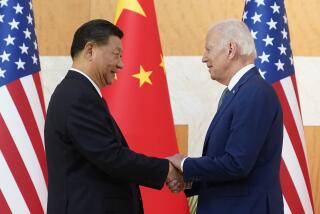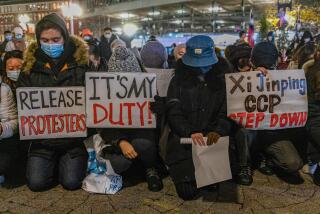Volcano in the Himalayas
- Share via
Last week’s riots in Lhasa, the historic capital of Tibet, seemed to come out of nowhere -- Tibetan protesters marched through the streets, burning vehicles and attacking police and ordinary Chinese, leaving as many as 100 dead.
Many American media outlets reported the demonstrations as if they were a complete surprise. After all, as growing numbers of ethnic Chinese business people and tourists have arrived in Tibet in recent years, they have brought what on the surface appears to be an economic boom to Lhasa. As shopping malls went up across the city, young Tibetans (or some of them anyway) seemed to be assimilating to Chinese rule.
But in truth, the riots should not have been so unexpected. Although it’s true that, in most of China, the government’s suppression of protest has become more sophisticated, milder and effective, over the last two decades in Tibet, Beijing has continued to rely on old-school hardball tactics. This includes a religious and social repression so intense -- and allowing so little freedom -- that it was inevitable Tibetans eventually would rise up. Though Tibet’s image in the West is one of peace-loving monks led by a Dalai Lama deeply committed to nonviolence, a younger generation of Tibetans is becoming increasingly desperate for any way to get out from under Chinese rule.
This is not the first time Tibet has gone up in flames since China took it over in 1951. In 1987 and 1988, after a slight opening allowed a degree of dissent, nuns, monks and lay citizens launched anti-China and pro-independence protests across Tibet. These demonstrations escalated into urban warfare, while the rest of China in this period of openness erupted in protests as well, which culminated in the bloody Tiananmen Square crackdown.
But since 1989, the Beijing government has shied away from obvious, bloody methods like the Tiananmen killing. Instead of open suppression, Beijing has allowed greater religious and economic freedom in much of China, while using increased surveillance to ensure that freedoms do not translate into organized political activity. If Chinese citizens do attempt to form political groups, Beijing still cracks down hard -- but tries to do so with as little fanfare as possible. Through more effective monitoring and disruption of activist groups, Chinese authorities for two decades have been able to prevent any Tiananmen-style protest from igniting and to keep most violent responses by the government largely out of the media’s view.
But Tibet remains far different. Unlike eastern Chinese cities, where real middle classes are developing, Lhasa is turning into an unequal Latin American-style metropolis.
When I last visited in 2006, I met a tiny elite of Chinese, and a few ethnic Tibetans, who had benefited from the economic development. These nouveau riches live it up, tossing down hundreds of yuan, the Chinese currency, at upscale Lhasa nightclubs.
Meanwhile, for most Tibetans, the growth story remains a fantasy. With growing Chinese migration to Tibetan areas, Tibetans have been cut out of profitable businesses, including the tourist shops surrounding Lhasa’s holiest sites. Unlike in other parts of China, in Tibetan regions, real private entrepreneurs have trouble launching companies because the state’s hand remains so strong. Studies show that Tibetans have some of the highest poverty rates in China, as well as one of the lowest education and highest infant mortality levels.
This poverty comes out each evening. At night, crowds of destitute Tibetans wander the streets of Lhasa, drinking cheap liquor or begging for small change. Along many side streets, thin Tibetan girls offer sexual services in the back rooms of barbershops.
In the countryside, meanwhile, the influx of traders from other Chinese provinces has deprived some traditional Tibetan herders of their living by making it difficult for them to sell their own goods at reasonable prices. Nomads now wander to Lhasa in search of work, and usually find none because they have no skills for urban jobs.
Religious and social repression in Tibet remains far more intense than in other parts of China, perhaps because Beijing fears an independence sentiment in Tibet that remains strong. Chinese intelligence officers patrol inside monasteries, launching “patriotic campaigns” that hark back to the Cultural Revolution but have disappeared in much of the rest of China. While troops are rarely seen in other Chinese cities, soldiers frequently patrol the streets of Lhasa or engage in nearby military exercises.
In Tibet, the Chinese authorities even remove monks -- and sometimes imprison and torture them -- for “crimes” as simple as possessing a picture of their revered Dalai Lama. When the Dalai Lama declared in 1995 that, according to Tibet’s system of reincarnation, he had recognized a young boy in Tibet as the new second-highest lama, Chinese authorities kidnapped the child, who apparently remains under house arrest in Beijing.
Unlike in other parts of China, in Tibet even lay people are not always allowed to fully practice their faith. In some Tibetan regions, Chinese authorities force families to pull children out of religious education classes. Last year, according to the U.S. State Department’s annual human rights report, Chinese authorities reportedly even arrested a number of Tibetan teenagers, including some as young as 14, just for calling for the return of the Dalai Lama. In jail, these children allegedly were beaten badly and subjected to electric shocks.
Increasingly sophisticated, younger, urban Tibetans also have grown increasingly frustrated -- and even violent. As travel restrictions have loosened in China, more Tibetans have visited prosperous Chinese cities, returning home to confront their own lack of development. As a new train link to the rest of China brings more Chinese tourists and business people to Tibet, Tibetans worry that their culture and society will be destroyed, part of what the Dalai Lama has called “cultural genocide.”
On my trip to Tibet two years ago, I found young business people, tour guides, even monks so desperate that they talked of organizing violent resistance to Chinese rule (despite the Dalai Lama’s long-standing preference for a peaceful “middle way” that would lead to greater autonomy without an independent state). Indeed, as decades of nonviolence have resulted in few gains for Tibetans (while China grows into a global power and wins international respect), some young Tibetans have begun to wonder if they need to change their strategy. In fact, in many isolated and largely unreported cases over the last decade, monks inside Tibetan monasteries have clashed violently with police.
Last week, all this anger exploded. And unlike in the rest of the country, China has responded with the fist, rolling tanks into Lhasa and declaring that Tibetan protesters must surrender. Chinese officials too seemed startled by the rapid escalation of the Tibet riots. Yet after two decades of treating Tibet differently, Beijing shouldn’t have been so shocked.
More to Read
Sign up for Essential California
The most important California stories and recommendations in your inbox every morning.
You may occasionally receive promotional content from the Los Angeles Times.










